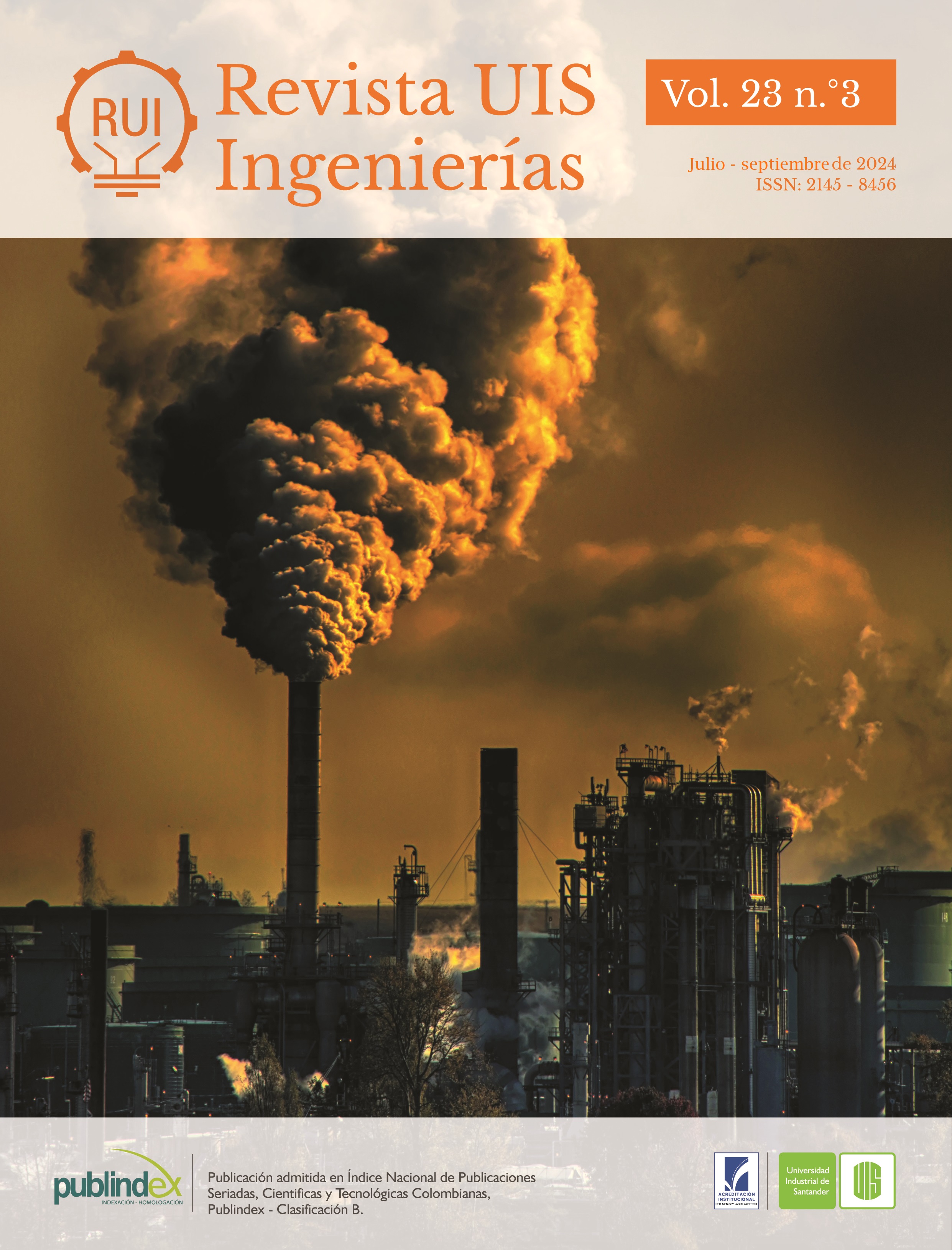Published 2024-10-10
Keywords
- FACSAT-3,
- Requirementes,
- satellite constellation,
- nanosatellite,
- stakeholders
- space mission,
- Earth observation,
- remote sensing,
- mission mangement,
- engieering systems ...More
How to Cite
Copyright (c) 2024 Revista UIS Ingenierías

This work is licensed under a Creative Commons Attribution-NoDerivatives 4.0 International License.
Abstract
Colombia has embarked on its journey into the space era through the FACSAT program, led by the Colombian Aerospace Force, aiming to deploy satellites in low Earth orbit. Following the successful launches of FACSAT-1 and FACSAT-2, the focus has shifted towards the mission design of FACSAT-3, a constellation consisting of three satellites intended for terrestrial observation, with the possibility of incorporating secondary payloads for various applications. Defining the mission's objective stands as a pivotal step in this process. Specialized literature recommends the analysis of project stakeholders as a fundamental method for establishing the requirements of any space mission. In the case of FACSAT-3, an exhaustive analysis of the needs of these stakeholders was performed through surveys and meetings with numerous participants at the national level. Once these needs were identified, the formulation of the requirements, ensuring that the satellite constellation could fulfill them. With operational and functional requirements in place, the constellation is ready to advance to the design phase. This article presents the methodology implemented these essential preliminary requirements identification within the context of the FACSAT-3 mission.
Downloads
References
- E. S. Rincón, “Capacidades de diseño de misiones espaciales de la Fuerza Aérea Colombiana”, IV Encuentro de Investigación, Desarrollo e Innovación en el Sector Aeronáutico, 29-31, 2021.
- E. Kulu, “Nanosatellite Launch Forecasts - Track Record and Latest Prediction,” 35th Annual Small Satellite Conf., Paper SSC22-S1-04, 6-11, 2022.
- Brycetech, Smallsats by the Numbers 2023. Brycetech, 2023. [en línea]. Disponible: https://newspaceeconomy.ca/2023/02/12/brycetech-smallsats-by-the-numbers-2023/
- S. Rincón, “MISIÓN FACSAT-2: Avance del programa espacial colombiano”, ACIEM, vol. 147, p. 36–40, 2022. [En línea]. Disponible: https://www.capacitacion.aciem.com.co/Especiales_Revista/2022/Oct_05/Revista-ACIEM-147-36-40.pdf
- W. Larson, J. Wertz, Space Mission Analysis and Design, 3rd ed, vol. 1. California: Space Technology Library, 2005.
- J. R. Wertz, D. F. Everett, J. J. Puschell, Space Mission Engineering: The New Smad. Torrance: Microcosm Press, 2011.
- Cooperación Europea para la Normalización Espacial, “ECSS‐M‐ST‐10C Rev. 1- – Project planning and implementation,” ECSS‐M‐ST‐10C, 06 de marzo de 2009. [En línea]. Disponible: https://ecss.nl/standard/ecss-m-st-10c-rev-1-project-planning-and-implementation/
- E. Freeman, “Strategic Management a Stakeholder Approach”, University of Virginia, 2015, doi: https://doi.org/10.1017/CBO9781139192675
- DNP, “Metodología General Ajustada Para La Formulación de Proyectos de Inversión Pública En Colombia”, vol. 2. Bogotá: Departamento Nacional de Planeación, 2023.
- S. Rincon, et. al, “Development of the Colombian Space Program”, International Astronautical Federation, 2022. [En línea]. Disponible: https://iafastro.directory/iac/archive/browse/IAC-22/B4/1/73664/
- S. Rincón, J. M. Cárdenas, K. N. Pirazan, I. Acero, R. Hurtado, E. Cortés, “Diseño Crítico del nanosatélite de la misión FACSAT-2 para la observación y análisis del territorio colombiano”, Revista UIS Ingenierías, 2023, doi: https://doi.org/10.18273/revuin.v22n3-2023006
- M. A. Viscio, N. Viola, R. Fusaro, V. Basso, “Methodology for requirements definition of complex space missions and systems,” Acta Astronautica, vol. 114, pp. 79–92, 2015, doi: https://doi.org/10.1016/j.actaastro.2015.04.018
- R. Fusaro, N. Viola, F. Fenoglio, F. Santoro, “Conceptual design of a crewed reusable space transportation system aimed at parabolic flights: stakeholder analysis, mission concept selection, and spacecraft architecture definition,” CEAS Space Journal, vol. 9, no. 1, pp. 5–34, 2016, doi: https://doi.org/10.1007/s12567-016-0131-7
- Agencia Espacial Brasileira AEB, “Catálogo da Indústria e Empresa Espaciais Brasileira”, Ministério da Ciência, Tecnologia e Inovações, 2021. [En línea]. Disponible: https://www.gov.br/aeb/pt-br/centrais-de-conteudo/publicacoes/catalogos-aeb
- C. Cappelletti, D. Robson, “CubeSat missions and applications”, Cubesat handbook: from mission design to operations, pp. 53-65, 2021, doi: https://doi.org/10.1016/B978-0-12-817884-3.00002-3
- A. Camps, “Nanosatellites and Applications to Commercial and Scientific Missions,” in Satellites Missions and Technologies for Geosciences, IntechOpen, 2020, doi: https://doi.org/10.5772/intechopen.90039
- Plan Nacional de Desarrollo 2022-2026 “Colombia Potencia Mundial de La Vida.” Bogotá: Departamento de Planeación Nacional, 2022.
- FAC, Estrategia para el Desarrollo Aéreo y Espacial 2042. Bogotá: Fuerza Aeroespacial Colombiana, 2023.
- Spot Image, “Niveles de Preprocesamiento y Precisión de Localización”, Airbus Intelligence, 2006.
- Caracol Radio Medellín, “El Buchón de Agua invade embalse de Hidroituango”, Caracol Radio. [En línea]. Disponible: https://caracol.com.co/emisora/2019/05/05/medellin/1557017312_038251.html
- H. Benavides, “Análisis multitemporal de pérdida de bosque de la región amazónica del municipio de Mapiripán en el departamento del Meta entre los años 2015 a 2022,” monografía, Universidad Antonio Nariño, 2023.
- INCOSE-TP-2010-006-04, “Guide to Writing Requirements”, Rev 3.1, 2022. [En línea]. Disponible: https://www.incose.org/docs/default-source/working-groups/requirements-wg/rwg_products/incose_rwg_gtwr_summary_sheet_2022.pdf

